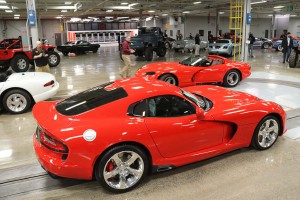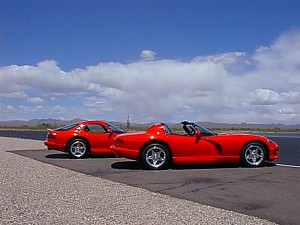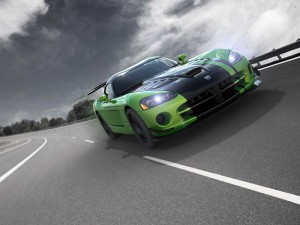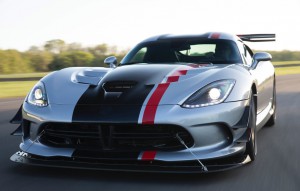The original Dodge Viper was an icon of the 1990s, even though it never came close to matching the sales of America’s other domestic sports car, the Chevrolet Corvette. Shortly after it emerged from bankruptcy in 2010, Chrysler finally pulled the plug on the snake, but after merging with Fiat, brought it back to life four years later, albeit to a largely indifferent market.
Fiat Chrysler has not only pulled the plug on the Viper but is in the process of converting its Detroit assembly plant into a conference center and museum. But could the Dodge Viper rise from the grave, Lazarus-like, for a second time? That appears to be a distinct possibility, at least according to several new reports.
“A new Viper is happening,” at least according to one of those sources, Car and Driver, though, if true, we could see some distinct changes made to the once-popular snake that could take some loyalists by surprise, starting with the replacement of the distinctive V-10 engine that has been a hallmark of the nameplate since the first Viper Roadster debuted more than a quarter century ago.
For those who still want the most recent version of the Viper, you actually might find one lying around on a dealer lot. FCA sales reports show the company has sold 11 this year, two in April, and perhaps another one or two will be counted in the carmaker’s May numbers when they are released later this week. It’s an ignominious end for a sports car that once put a bright halo around the Chrysler Corp. brand.

The last Viper - and the original Viper Concept - will join 400 other classics kept at the newly renamed Conner Center — or is it?
(Back from the Dead: Chrysler finds new use for old Viper plant. Click Here for the story.)
The original Viper was the brainchild of Bob Lutz, Francois Castaing and Tom Gale, the trio of executives who effectively ran Chrysler in the late ’80s and early ’90s. Lutz, the former Marine and ultimate car guy – who later went on to serve a similar role at General Motors – wanted to build a classic American sports car that had raw power and none of the “nanny” systems that were just beginning to show up in more mainstream models.
Think Shelby Cobra. The Viper Roadster, which debuted in 1992, didn’t even have antilock brakes or an airbag. But it had a massive V-10 that was one of the most powerful engines on the road during that era. A few niceties were added with the launch of the Viper Coupe, but the snake was all about raw power and sleek looks, not much else. Features like airbags and ABS were reluctantly added, only because of federal mandates, before Viper production was halted in 2010.
An all-new version debuted three years later. Despite an all-new design and some significant mechanical updates, the reborn sports car clearly looked like a Viper – and it was motivated by – of course – a new version of the familiar V-10 engine making 640 horsepower and 600 pound-feet of torque. Perhaps more significantly, FCA lead designer and project chief Ralph Gilles declared that his goal was to create “a more forgiving car to drive and accessible to more people.”
Ironically, it may have had a broader market in mind, but the reborn Viper seemed to click with only a few diehard nameplate loyalists. Sales falling well short of even the original’s niche numbers, production again shut down last year. The Connor Road Assembly Plant’s machinery is gone and the factory is in the process of being converted into a corporate conference center, as well as an FCA museum.
Yet Fiat Chrysler’s love affair with the snake apparently hasn’t ended, according to reports by both C&D and website Allpar. They are both confident that a replacement is in the works.
(Click Here for more about the end of the Dodge Viper.)
Those familiar with the most recent version of the Viper may recall the original scuttlebutt suggested it would share a European-derived platform. Apparently, that is a high likelihood if the Viper does return, Allpar suggesting the American sports car will share platforms with the Maserati Alfieri, the eagerly anticipated replacement for the Gran Turismo, as well as the new Alfa Romeo 6C/8C.
Car and Driver, for its part, anticipates FCA will follow the approach used for the original Viper, launching with a roadster edition and following up, a couple years later, with a coupe.
Both C&D and Allpar agree that the revived Viper would abandon the familiar V-10, opting for a V-8. A naturally aspirated version, somewhere in the 500 hp range could come first, with a supercharged package to follow. A version of the massive Hellcat engine? That would be a lot to stuff into the new car, especially if it goes with the rumored mid-front layout. But the V-10 wasn’t exactly tiny. And 700 is a nice number, especially considering a next-generation Viper would have to go up against the long-awaited, mid-engine Corvette that Chevrolet seems finally ready to reveal.
With Connor Avenue unavailable, the expectation is that a new Viper very well might be outsourced to a supplier like Michigan’s Prefix Corp., which already produced specialty versions of the most recent snake. But if Allpar’s expectations are on target, could we see the new Viper roll off the same line as the Alfieri and 8C?
As for timing, C&D foresees the possibility the all-new Viper will debut at next January’s North American International Auto Show in Detroit, with production to follow a year or two later. That would fit with the anticipated timing of the new Maserati and Alfa models. But Allpar pushes the timeline back a year or two.
(To see more about Hagerty’s opinion on used Vipers, Click Here.)
Is there more than smoke blowing here? Hard to tell, but we hope to have more details in the months to come.




There are three problems with the Viper: Styling, Styling, and Styling.
Beauty is in the eye of the beholder. Look at some of the more recent Lamborghinis, which (I assume) sold out, probably before production even began.